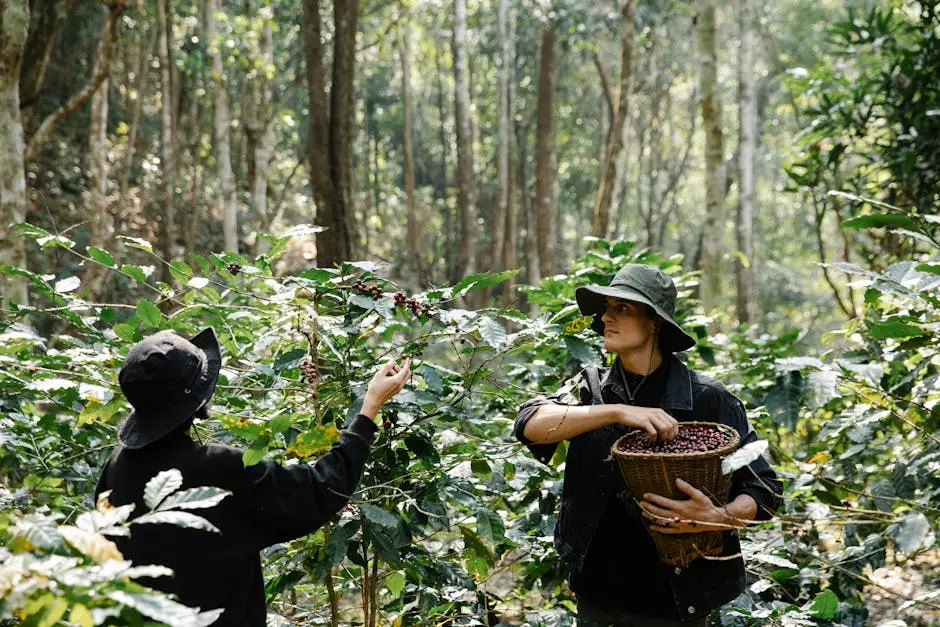The Journey of Organic Coffee Beans to Your Monroe Cup
In today's fast-paced world, many of us start our day with a comforting cup of coffee. But have you ever wondered about the journey those aromatic organic coffee beans have taken before reaching your Monroe cup? This blog takes you through the fascinating process of how organic coffee gets from farm to cup, ensuring quality at every step.

Cultivating the Finest Organic Coffee Beans
Organic farming methods are at the heart of producing high-quality coffee beans. Farmers carefully select locations with the perfect climate and soil, ensuring the beans grow in the best conditions. This careful selection is vital since the environment influences everything from the plant's health to the complexity of flavors in each bean. Farmers often use sustainable practices such as shade-grown methods, which not only protect the coffee plants but also promote biodiversity. By avoiding harmful pesticides and fertilizers, they maintain the integrity of the soil and the surrounding ecosystem. This commitment to nature not only benefits the environment but also ensures the coffee beans are 100% organic, free from synthetic chemicals Unraveling the Mysteries of 100% organic coffee.
In addition to the ecological advantages, organic coffee farming has a meaningful social impact. Many farmers engage in fair trade practices, which ensure they receive fair compensation for their hard work and dedication to quality. This fair trade model not only supports the farmers' livelihoods but also fosters community development, enabling them to invest in better farming practices and education. As a result, consumers who choose organic coffee contribute to a system that values ethical sourcing and social responsibility Coffee Subscription.
Harvesting and Processing: Preserving Quality
The harvesting process is perhaps one of the most labor-intensive yet rewarding stages of coffee production. With organic coffee, the cherries are picked by hand to ensure only the ripest ones are harvested. This method requires a keen eye and patience, as the cherries do not all ripen at the same time. The manual selection helps to preserve the quality and flavor of the coffee, providing a rich and consistent taste. After harvesting, the cherries are processed promptly to prevent spoilage. In the wet method, cherries go through depulping, fermentation, and washing, ensuring a clean flavor profile. The dry method, on the other hand, allows cherries to dry in the sun, imbuing the beans with deeper flavors. Each method has its own benefits, and the choice depends on climatic conditions and the desired taste profile.
Sustainability comes into play once more during processing. Many organic coffee producers utilize eco-pulping machines that minimize water usage, making this crucial phase more environmentally friendly. These efforts support long-term environmental health and play a part in preserving the delicate balance of nature. The processed beans are then carefully dried, often under the heat of the sun, which not only uses minimal energy but also enhances the intrinsic flavors of the beans JD Brews Coffee Co..
Roasting: Unlocking Flavor and Aroma
Roasting is the transformative stage where green coffee beans develop their rich aroma and flavor. This intricate process involves heating the beans to precise temperatures, causing a series of chemical reactions known as the Maillard reaction. It is during roasting that beans release oil, leading to the classic brown hue and complex flavors coffee lovers cherish. Roasters tailor their methods to bring out the best in each bean; a light roast may highlight fruity or floral notes, while a dark roast can produce robust, bold flavors.
For organic coffee, roasting is undertaken with the utmost care to preserve the beans' pristine qualities. This means avoiding any artificial additives or flavor enhancers, and sometimes even employing eco-friendly roasting technology that cuts down on carbon emissions. The choice of roasting style can significantly influence your coffee's taste, ranging from sweet, nuanced flavors to rich, earthy tones. As beans roast, their originally vibrant green color deepens, filling the roastery with a tantalizing aroma. Experienced roasters listen for the 'first crack,' a sign that the beans have reached the perfect temperature to ensure peak flavor without bitterness Nectar of Life Coffee.
From Roaster to Cup: The Final Steps
With roasting complete, the journey moves towards preserving freshness. Packaging plays a crucial role here, where specially designed bags with one-way valves allow gases to escape without letting oxygen in. This ensures the beans stay at their freshest until they reach coffee enthusiasts. On reaching local coffee shops like Monroe, beans are finally ground and brewed by skilled baristas. At this stage, the barista's expertise brings the entire journey together, locking in the best elements of the beans into each cup.
The ritual of brewing is the culmination of the entire organic coffee odyssey. Whether prepared as an espresso, pour-over, or cold brew, each method has its unique impact on the flavor and aroma of the coffee. Baristas select the grind size suited to the brewing method, ensuring optimal extraction of the beans' essence. This part of the journey marks the final transition of the coffee beans from farm to your cup, capturing the effort and passion invested by everyone along the way. Embrace this transition and the warm notes of your Monroe coffee, knowing you're sipping on a beverage of uncompromised integrity Our Promise.
Savoring the Journey in Every Sip
From the lush coffee plantations to the moment the warm cup reaches your hands, the journey of organic coffee beans is a testament to dedication, quality, and care. Next time you sip your Monroe coffee, remember the incredible odyssey it underwent to give you that perfect taste.

